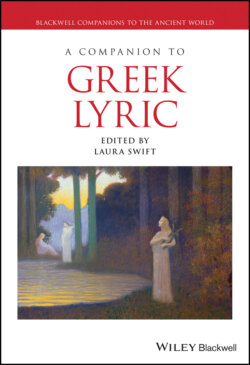Читать книгу A Companion to Greek Lyric - Группа авторов - Страница 70
Editorial Symbols
ОглавлениеThe standard editorial sigla, which are collectively known as the “Leiden conventions,” reflect a twofold imperative: to represent faithfully what appears on a papyrus and to indicate any interventions by the editor. For literary papyri, the two most common symbols are the sublinear dot and square brackets, but they are by no means the only ones:
αβγ letters read with confidence
α̣β̣γ. letters read with doubt
. . . ink observed, but letters uncertain (one for each dot)
[ ] gap or lacuna in the text (cf. vacat, which is used for space left intentionally blank)
[. . . .̣] gap or lacuna in the text; estimated number of missing letters (one for each dot)
[αβγ] letters supplied by editor to fill a gap/lacuna
⟨αβγ⟩ letters omitted by scribe and inserted by editor
{αβγ} letters read on the papyrus but deleted by editor
⟦αβγ⟧ letters on papyrus deleted by ancient scribe
⌊αβγ⌋ letters supplied or confirmed by a secondary witness
⸌αβγ⸍ letters inserted above the line by the scribe
†αβγ† letters read on papyrus that defy analysis (i.e., corrupt text)
(αβγ) resolution by editor of a symbol or abbreviation on papyrus (uncommon in literary papyri)
Because these symbols are not easily transferred to a translation, the study of Greek lyric is by necessity demanding, specialized work.
For the purposes of illustration, we might consider the first column of P.Fouad inv. 239 (Figure 7.1) both as first published by Lobel and Page (1952) and subsequently reedited by Eva-Maria Voigt. The former tentatively attributed the poem to Alcaeus, but since Treu (1976: 161–164) the case for Sappho has been endorsed by many editors, including most recently by Battezzato 2018. The appearance of an asterisk on the papyrus, however, renders the case for Sappho problematic (de Kreij 2022).
Figure 7.1 P.Fouad inv. 239: lyrics by Sappho or Alcaeus. An asterisk is visible in the left margin of the second column, opposite line 2. (© Institut français d&38217;archéologie orientale du Caire.)
| Lobel-Page 1952 | Sappho fr. 44a Voigt | |
| ]ϲανορεϲ̣ ̣ ̣[]μ̣αιτονετικτεκόω ̣[]ονιδαιμεγαλωνύμ ̣[]μεγανορκοναπωμοϲε]λαν · ά⟦ε⟧ϊπαρθενοϲεϲϲομαι] ̣ωνορέωνκορύφα̣ι̣ϲέπι]δ̣ενευϲονέμανχαριν·] ̣εθέωνμακαρωνπατηρ·]ολοναγροτέρανθέο̣ι] ̣ϲινεπωνύμιονμεγα·]εροϲουδάμαπίλναται·] ̣[ ̣] . . . .α̣φόβε[ ̣ ̣] ́ ̣ω· | 510 | ]ϲανορεϲ̣ ̣ ̣[[Φοίβωι χρυσοκό]μ̣αι τὸν ἔτικτε Κόω ̣[[μίγειϲ(α) Κρ]ονίδαι μεγαλωνύμω̣⟨ι⟩[Ἄρτεμιϲ δὲ θέων] μέγαν ὄρκον ἀπώμοϲεκεφά]λαν· ἄϊ πάρθενοϲ ἔϲϲομαι] ̣ων ὀρέων κορύφα̣ι̣ϲ’ ἔπι]δ̣ε νεῦϲον ἔμαν χάριν·ένευ]ϲ̣ε θέων μακάρων πάτηρ·ἐλαφάβ]ολον ἀγροτέραν θέο̣ι].ϲιν ἐπωνύμιον μέγα·]εροϲ οὐδάμα πίλναται·] ̣[ ̣] . . . .α̣φόβε[ ̣ ̣] ́ ̣ω · |
[ … golden-haired Phoebus,] whom [the daughter of] Koios bore, [mingling] with Kronos’ mighty-named son. [But Artemis] swore a great oath … “I will always be a maiden … on the peaks of mountains … grant my favor …” The father of the blessed gods agreed … the gods [call her deer-]shooter, huntress … a great title … Eros(?) never approaches her.
The relative paucity of dots indicates that the extant text is fairly secure, but it is by no means complete: the square brackets at left indicate that only the right side of the column survives. Lobel-Page’s text represents what the ancient scribe wrote: occasional accents on the papyrus mark the Aeolic dialect’s characteristic barytonēsis (= recessive accent); punctuation in the form of a raised dot appears in lines 5, 7, 8, 10, and 11. The scribe also deleted an epsilon in line five, which changes ἀεί into Aeolic ἄϊ. Voigt’s articulated edition, by contrast, includes the interventions of modern editors, namely, the third line’s addition of iota adscript (to make the dative case explicit) as well as several textual supplements in square brackets to the left of lines 2–4 and 8–9. Those supplements are not chosen at random (see further, on Dialect and Meter, below), but they must nonetheless be understood as additions to the extant text (on which, see further, The Readings, below).
